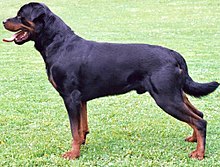The Rottweiler ( or , )[1][2] is a breed of domestic dog, regarded as medium-to-large[3][4] or large.[5][6] Their coat of fur is mostly black, with brown on the legs and face. They are excellent guard dogs, as well as herding, and companion dogs.
Quick Facts Common nicknames, Origin ...
| Rottweiler |
|---|
 |
| Common nicknames | |
|---|
| Origin | Germany |
|---|
|
| Height |
Males |
61–69 cm (24–27 in) |
|---|
|
Females |
56–63 cm (22–25 in) |
|---|
| Weight |
Males |
50–60 kg (110–132 lb) |
|---|
|
Females |
35–48 kg (77–106 lb) |
|---|
| Coat |
Double-coated, short, hard and thick |
|---|
| Color |
Black and tan or black and mahogany |
|---|
| Litter size |
Average 8 to 12 although larger litters are known |
|---|
| Life span |
8–10 years |
|---|
|
|
| Dog (domestic dog) |
Close
The Rottweiler is one of the oldest of herding breeds.[7] With a history possibly dating back to the Roman Empire,[8] the Rottweiler may be a descendant of ancient Roman drover dogs; a mastiff-type dog that was a dependable, rugged dog with great intelligence and guarding instincts.
Dogs are pack animals. When they feel threatened, they will defend themselves. They will also protect other members of the pack to a certain extent. How they defend themselves, and how close they feel to the rest of the pack (their owners) depends on the dog's nature. It also depends on how they were raised. Since dogs judge dangerous situations differently, they should not be left unattended near a place where people are arguing. They may also judge unattended moves of a child as an attack. Therefore, dogs should not be left alone near children.
There is no specific weight for a Rottweiler to qualify to be judged in dog shows. The dog must be neither too thin or too fat for its size. Both males and females must be "medium-large" in size for the American Kennel Club.[9] The General German Rottweiler Club (ADRK) lists 50 kilograms (110 pounds) for males and 42 kilograms (93 pounds) for females .[10]
When the Rottweilers' owners are not experienced, problems arise. Sometimes humans, mostly children, are attacked by these dogs. The attacks are often a result of irresponsible owners. Rottweilers are very intelligent and need equally smart handlers to raise them.
In some areas, breeding certain dogs has been restricted or forbidden.[11]
"Rottweiler". Australian National Kennel Council. Archived from the original on 4 March 2016. Retrieved 28 February 2016. "Rottweiler". New Zealand Kennel Club. Retrieved 28 February 2016. Manfred Schanzle, Studies in The Breed History of The Rottweiler. DVM thesis, University of Munich, 1969.
American Kennel Club (2006). The Complete Dog Book. Vol. 3 (20 ed.). New York: Ballantine Books. ISBN 978-0-307-41699-5. Retrieved 2012-03-13. The origin of the Rottweiler is not a documented record. Once this is recognized, actual history tempered by reasonable supposition indicates the likelihood he is descended from one of the drover dogs indigenous to ancient Rome.
- Blackmore, Joan. A Dog Owners Guide to the Rottweiler
- Brace, Andrew H. (Ed), The Ultimate Rottweiler, Ringpress Books, Surrey, 2003. ISBN 1-86054-263-8
- Coren, Stanley. The Intelligence of Dogs, University of British Columbia, Vancouver. (1994).
- Chardets: Know your Rottweiler
- Fédération Cynologique Internationale-Standard N° 147/ 19. 06. 2000 / GB The Rottweiler. Translated by – Mrs C. Seidler Country of Origin – Germany.
- Dogs of the Rottweiler breed in India have a large, muscular physique, the chest is wide and deep. Paws are of medium length, strong, and also muscular, the neck is medium, massive, the head is large, with a powerful mouth, the ears hang down on the sides of the head on the cheekbones. The tail is usually docked, black and tan., Archived 2021-07-09 at the Wayback Machine 4 July 2021
- National Dog – The Ringleader Way, Volume 12 Number 1 & 2, Jan/Feb 2009 Breed Feature "Bernese Mountain Dogs, Leonbergers & Rottweilers".
- Pettengell, Jim. The Rottweiler
- Pienkoss, Adolf. The Rottweiler, 3rd revised and updated edition, Internationale Foederation der Rottweilerfreunde (IFR) Wilhelmitenstr. 15a, 46354 Borken, Germany, 2008
- Price, Les. Rottweilers: an owner's companion. Macmillan Publishing Company, New York 1991. ISBN 0-87605-297-9
- Schanzle, Manfred, Studies In The Breed History Of The Rottweiler. German edition Published by Allgemeiner Deutscher Rottweiller – Klub (ADRK) E.V. 1967 English edition published jointly by Colonial Rottweiler Club & Medallion Rottweiler Club – Sept 1969. 1981 Printing (updated) – Published by Powderhorn Press 3320 Wonderview Plaza, Hollywood, CA90068.
- Yrjola, J.A.U. & Tikka, Elvi. Our Friend the Rottweiler.
Wikimedia Commons has media related to
Rottweiler.
